Selling Online: How to Use Social Media for Ecommerce
The divide between ecommerce and social commerce is quickly disappearing.
But the one thing brands know for sure is that they need to be selling online.
Accelerated by the pandemic, global retail ecommerce sales are forecast to reach $6.388 trillion by 2024:
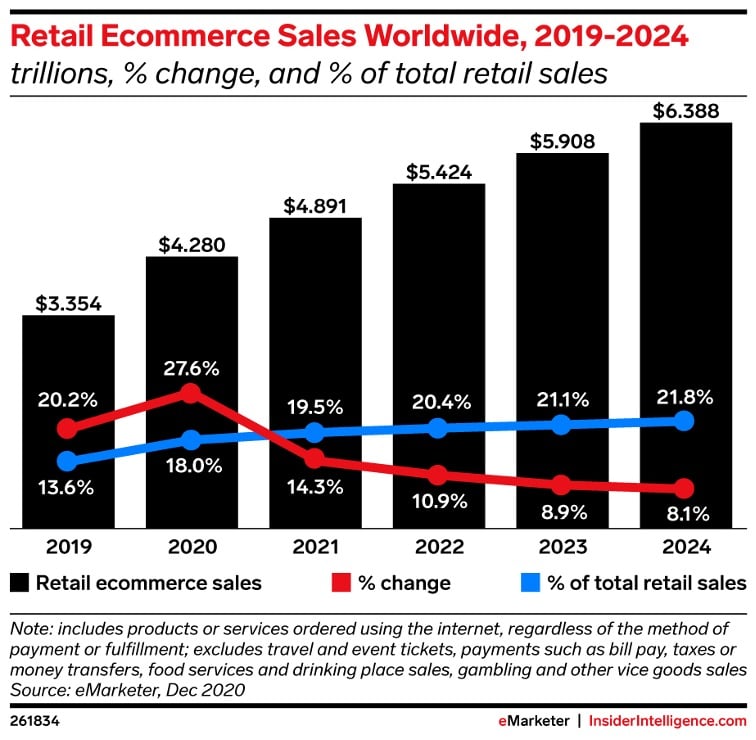
To amplify things even more, social media companies have entered the space and are developing more in-app features to make the online buying process frictionless.
Why jump to a separate checkout when you can handle everything seamlessly in one place?
In this guide, you’ll discover the subtle difference between ecommerce and social commerce, get a glimpse of the latest social commerce features on each platform, and learn how your brand can use social media strategy for ecommerce.

Manage all your social media accounts in one place.
Craft, schedule, & auto-post content to all your social channels, then track analytics and manage interactions from a single, easy-to-use dashboard.
What is Social Commerce?
Social commerce refers to the process of buying and selling products directly on social media platforms.
The entire shopping experience – from product discovery to the checkout – takes place on a social media platform, so customers don’t have to pass through to a separate ecommerce store like Shopify. For example, there’s:
- Marketplace on Facebook
- Catalog on WhatsApp
- Facebook Shops the online storefront on Facebook and Instagram
- Instagram Shopping
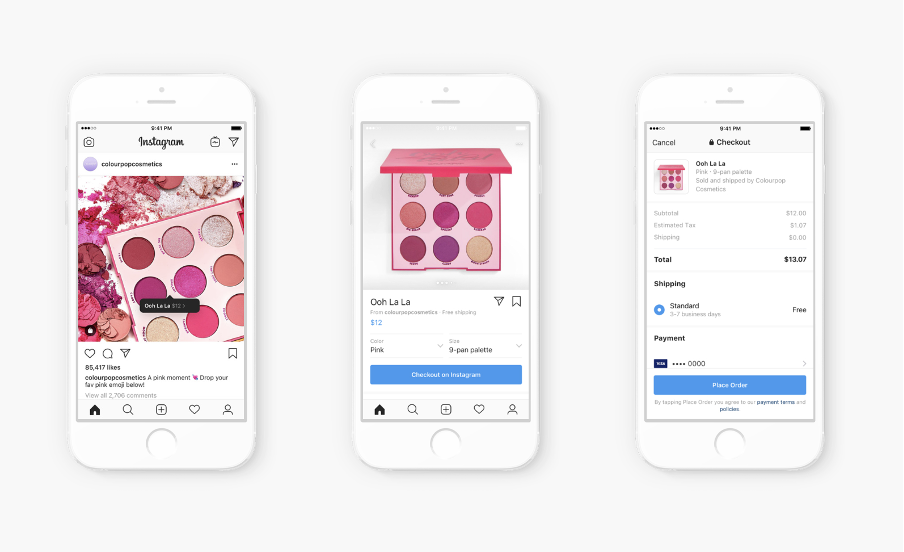
(We’ll look at more examples below).
Ecommerce, also known as electronic commerce or internet commerce, is buying and selling products or services online.
Customers select the goods through photos or product descriptions provided by the seller, either on social media or its online store. After that, the goods are delivered to the customer either physically or digitally, depending on the type of product or service.
Simply put: traditional commerce takes place in a physical store, ecommerce takes place on a website, and social commerce takes place on social media platforms.
Why Your Brand Should Care About Selling Online (on Social Media)
Asia already has a massive social commerce industry, particularly in China, where it’s worth $300 billion. And it’s also on the rise elsewhere.
Social commerce sales in the US are expected to reach $36.62 billion this year, a rise of 34% from $26.97 billion in 2020:
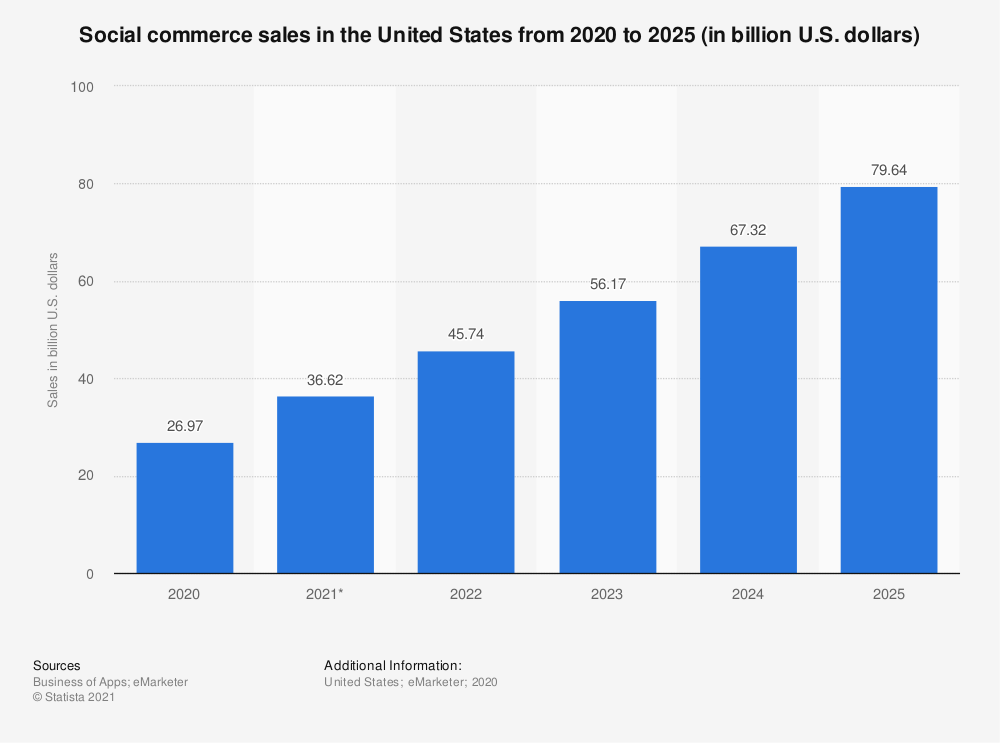
Furthermore, social commerce revenue in the US is projected to reach $79.64 billion in 2025 and account for 5.2 percent of its retail ecommerce sales.
It’s a known fact that young people determine what is trending and what drives consumer growth.
For instance, 11% of the 18-34 age group regularly use social media to purchase products, 37% have used it before but don’t use it regularly, with a further 27% either somewhat or very interested in trying it:
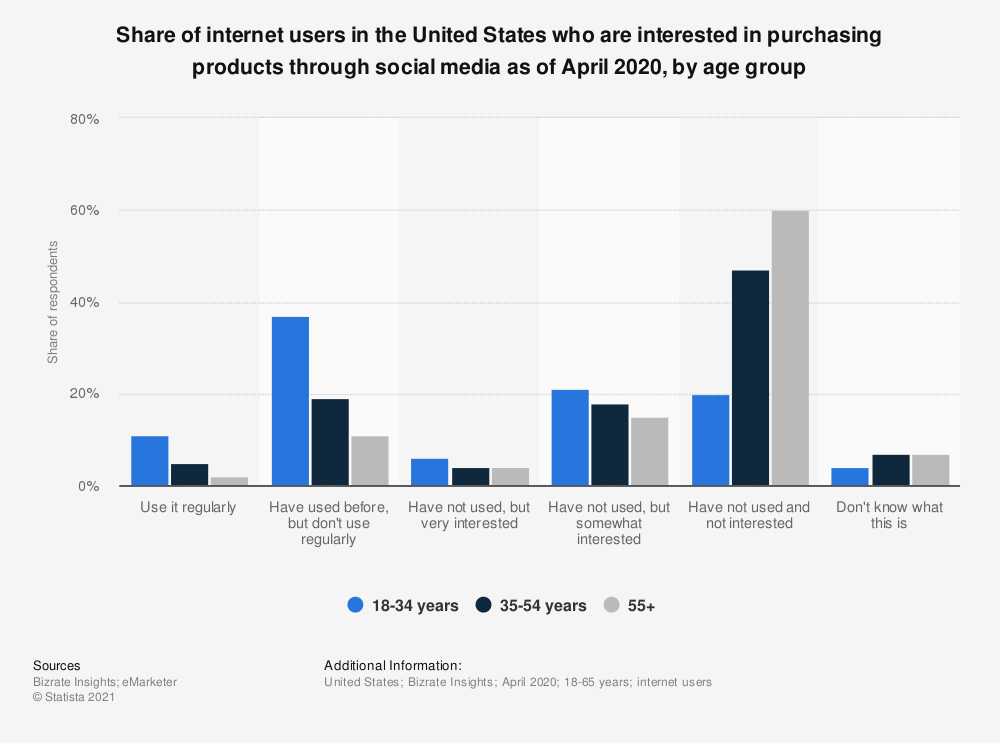
Social media also plays a crucial role in helping consumers find information for future purchases. In a recent survey of US social media users, 55% said they made a purchase after discovering a product through this channel. (11% said they purchased immediately, and 44% reported doing so later on.)
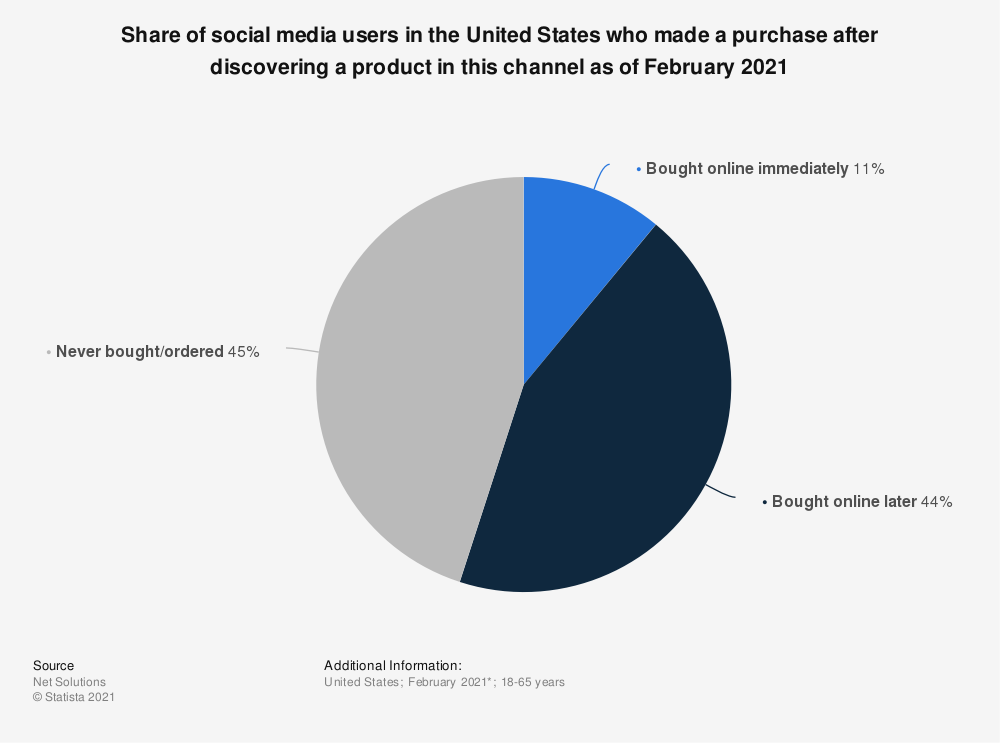
Increased sales is not the only reason why your brand should care about selling on social media. You can also benefit from:
- Improved customer communications
- Personalized customer experiences based on behavior
- Increased visibility of product listings
- Enhanced product reviews/recommendations
- Customer ability to share/interact with transaction details
- Improved customer journey/ease of purchase
In short: by selling on social media, you can expect more visibility, more engagement, more revenue, and more satisfied customers.
Social Commerce Features by Platform
Let’s take a look at the current and planned social commerce features your brand can harness on each platform.
- Facebook Shop is an online storefront where people can browse, explore and purchase your products directly on Facebook. You can create customizable collections (Catalogs) with simple design tools (Commerce Manager) to showcase featured products and bring your brand to life. Customers can browse and buy products directly in the app or get redirected to your website’s checkout.
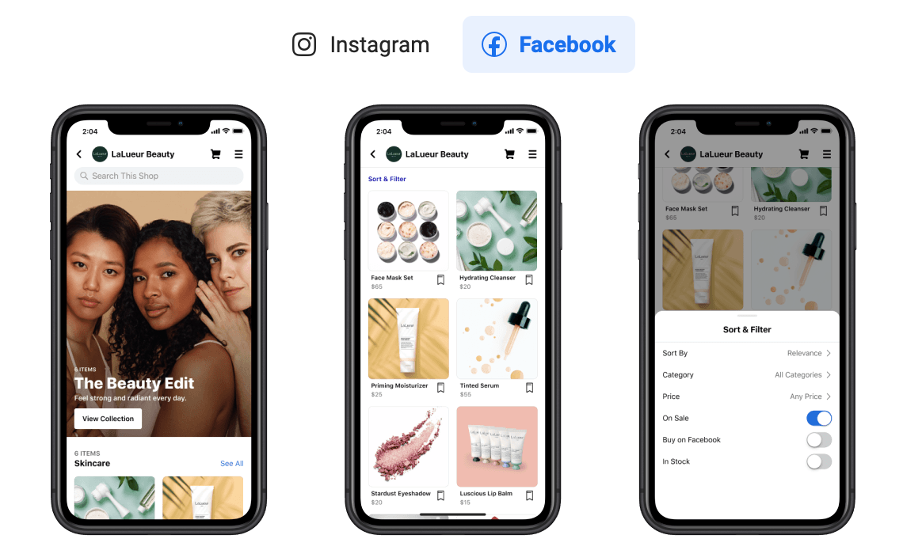
- Note: Facebook is now prompting old-style Facebook Page Shop owners to convert to a Facebook Shop.
- Facebook Marketplace allows people to browse listings, search for items for sale in their area, or find products available for shipping. Businesses can:
- Show inventory for retail items, home rentals, vehicles, and event tickets.
- Advertise their shop or items.
- Display new or refurbished items from their Facebook shop.
- Instagram Shop is an online storefront – the equivalent of the Facebook Shop (above) – where people can browse, explore and purchase your products directly on Instagram.
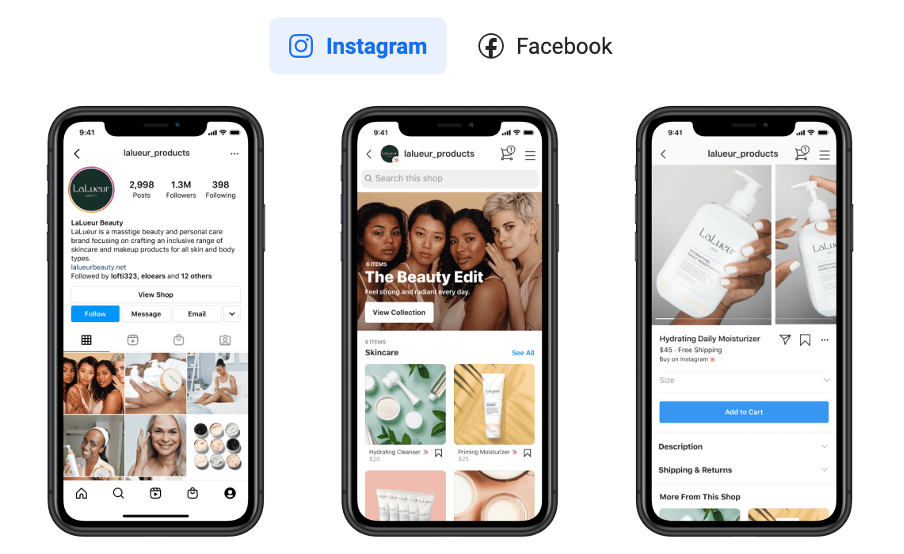
- Drops help sellers create buzz for new products in the lead-up to their launch. The products themselves are usually only available in limited supplies or for a short period to increase demand. Drops will be available inside the app at the top of the Shop tab. Shoppers can browse and make their Drops purchases directly in the Instagram app.
- Ecommerce experiments – Twitter is testing a new way to display tweets that link to third-party ecommerce product pages, e.g. on a Shopify store. The tweets will include a prominent “Shop” button and integrate product details directly into the tweet, including the product name, shop name, and product pricing.
- Shop Module is another Twitter pilot program underway in the US. “The Shop Module is a dedicated space at the top of a profile where businesses can showcase their products. When people visit a profile with the Shop Module enabled, they can scroll through the carousel of products and tap through on a single product to learn more and purchase — seamlessly in an in-app browser, without having to leave Twitter.”
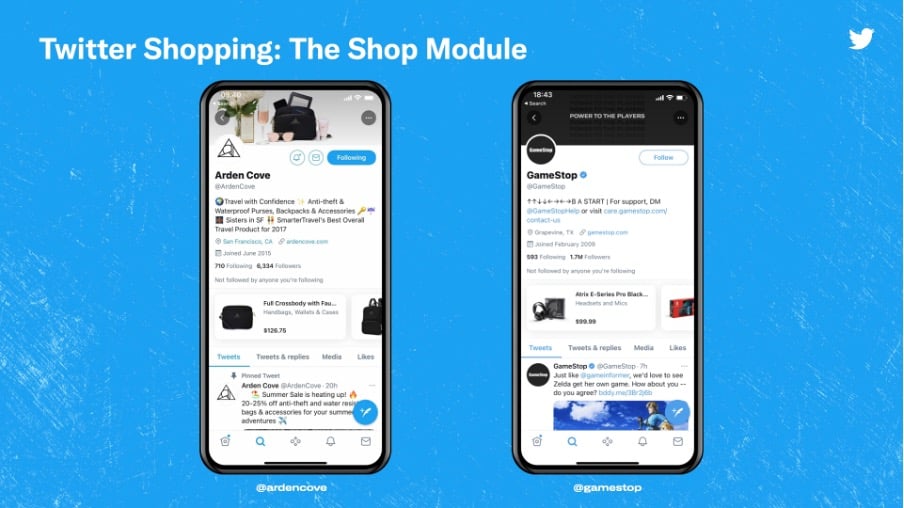
- Shoppable Pins come from Product Catalogs uploaded by verified retailers and merchants. Brands can also create Shopping ads to promote their Shoppable Product Pins.
- Shopping List automatically saves product pins in one place, making it easier for users to come back and shop for those items. Users will also be shown shipping costs, reviews, and get notified when a saved product pin has a price drop.
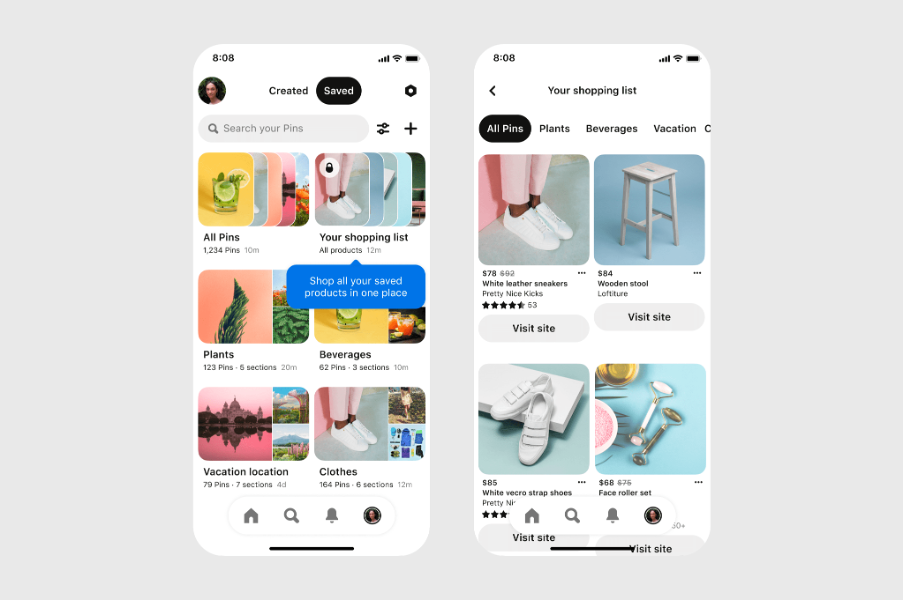
- The Shopify Pinterest channel is now live in over 27 countries, allowing more than 1.7 million Shopify merchants worldwide to bring their products to Pinterest and turn them into Shoppable Product Pins that are discoverable across the platform.
- The Goods is a rotating two-week curated online shop of exclusive products from DTC brands, including Outdoor Voices in its first batch.
YouTube
- Video selling allows creators to tag products that appear in their videos. Viewers can then browse and buy those products by clicking a shopping bag icon in the corner of the screen. (YouTube is currently testing this feature with a few brands. Plus, it’s exploring a partnership with Shopify and in-app payments.)
Snapchat
Snapchat has announced its intention to enter social commerce.
- This year, it has acquired the Berlin startup Fit Analytics and Screenshop, once called the Shazam of fashion.
- Previously it invested in Spring – a mobile shopping app that provides consumers with access to all their favorite brands in one place and operates as a virtual shopping center.
TikTok
- TikTok Shopping is the new Shopify x TikTok for Business collaboration bringing organic product discovery and shopping tabs to TikTok. Brands can add a shopping tab to their TikTok profiles and sync their product catalogs to create a mini-storefront that links directly to their online store for checkout. Kylie Cosmetics is one of the first pilot brands to let customers shop directly on TikTok.
Facebook, Instagram, and Pinterest are leading the way with social commerce features. But the other platforms are not far behind in terms of development and pilot testing.
Soon, brands will be able to choose which platforms they want to use based on the features and their target audience.
Examples of Successful Brands Selling Online via Social Media
Here is a selection of brands selling on various social media platforms.
Pink Tag Boutique – Facebook
Pink Tag Boutique is an online boutique in Louisville, Kentucky, founded by Britney Renbarger. The brand was already using Facebook to boost brand awareness and showcase its products, but customers had to buy on the store’s website.
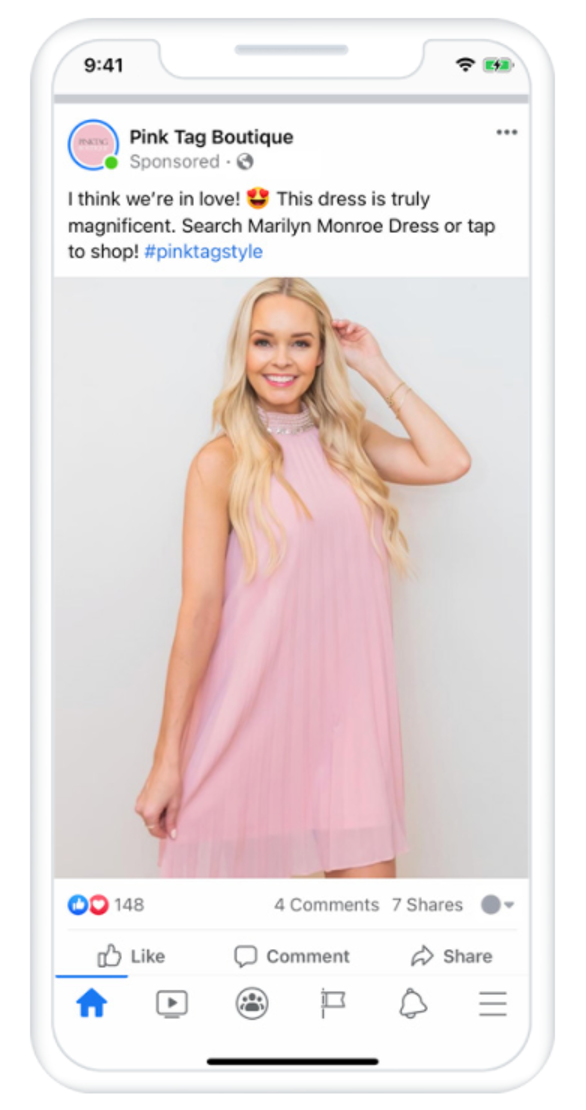
Its goal was to streamline online ordering through Facebook and increase customer engagement to boost sales.
First, they created a Facebook Shop so that consumers could purchase directly in-app.
They also used photo ads in the collection format to categorize products and make it easier for shoppers to browse and discover new items. Plus, they tagged products in posts and Stories so that people could easily click for more details.
Finally, they started using Live Shopping so that viewers could purchase featured items from the broadcast in the brand’s Shop.
Pink Tag Boutique revealed the following results after five months:
- $44,448 in incremental sales from its Facebook Shop.
- 804 total orders from its Facebook Shop.
- 66% greater average order value from buyers using its Facebook Shop than those who bought from the website ($65.79 versus $39.65).
Facebook products used:
Missoma – Instagram
Missoma is a UK-based jewelry brand offering contemporary, delicate, and personalized pieces. Most customers have discovered the brand through its social media channels and growing network of influencers.
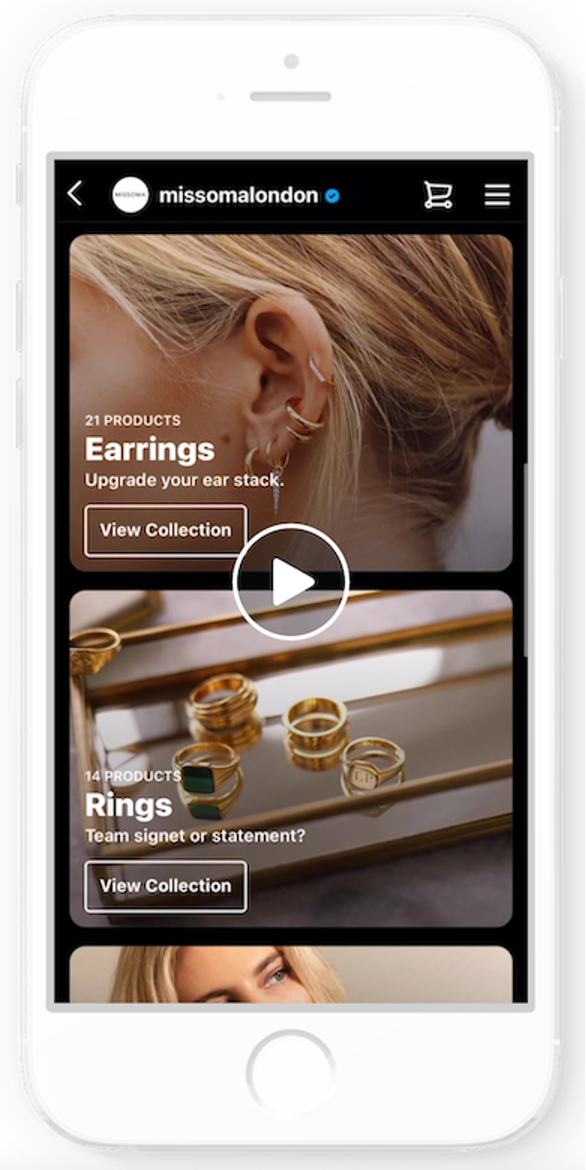
Missoma wanted to increase sales during the busy and competitive Christmas holiday shopping period, while also raising brand awareness.
It decided to add an Instagram Shop and organized items into special product categories, such as Best Sellers, Gifts, and its popular Lucy Williams Collection to help shoppers browse and discover products — and help the brand selling online.
Missoma also used Messenger and Instagram Direct to answer customer questions seamlessly as they browsed.
Missoma revealed the following results between November 16 and December 14, 2020:
- 45,459 new visitors to Missoma’s Instagram Shop.
- 52,250 total visitors to Missoma’s Instagram Shop.
- 29,690 adds to cart from Missoma’s Instagram Shop.
- 5,641 orders from Missoma’s Instagram Shop.
Instagram products used:
Sukoshi Mart – Pinterest
Sukoshi Mart is a small, Canadian-based business selling Japanese and Korean beauty skincare and makeup essentials, yummy Japanese snacks, cute stationery, and accessories for cozy everyday living.
Using the Pinterest integration with Shopify, it could access a new set of audiences, including one of its key demographics, Gen Z.
The brand uploaded its product catalog to Pinterest and created Product Pins so that customers could check the pricing and availability information.
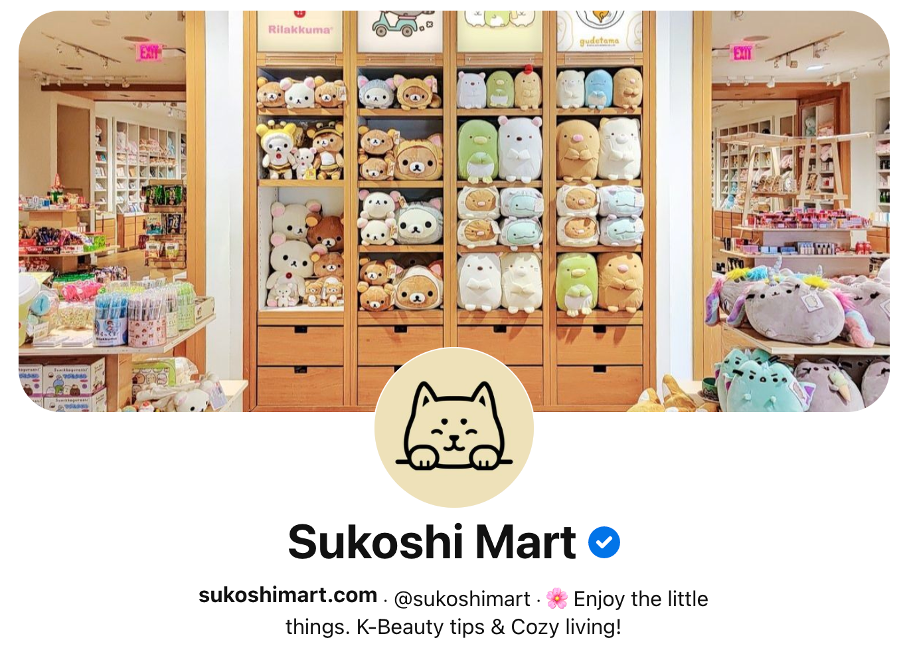
They also turned the Product Pins into shopping ads to target consumers interested in Japanese and Korean beauty products.
Using Pinterest, Sukoshi Mart saw a 3.5X higher return on ad spend than the industry average in Canada.
How to Build a Social Media Strategy for Ecommerce & Selling Online
By now, you’ll have a good understanding of social commerce features for each platform and some ideas of what works.
Next, it’s time to build your social media strategy for ecommerce, following this 5-step framework:
- Set your business goals
- Plan and produce your content
- Engage with your audience
- Measure your performance
- Rinse and repeat
Let’s start!
Step 1: Define your business goals
As with any social media strategy, the first step is to define your business goals so that you know where you’re heading and can measure your success.
Your goals for ecommerce might be:
- Increase the number of sales
- Grow reach and brand awareness
- Boost interaction rates on your posts and within your community
- Increase website traffic
- Simplify the buying process
- Streamline customer service
And you’ll also want to tailor your goals to each social network. For example, you might want to use Pinterest to drive more traffic to your Shopify store but use Facebook to simplify the buying process inside one platform.
Step 2: Plan and produce your content
Based on your goals, you’ll have an idea of the type of content you want to create to support ecommerce. But the key to success comes in planning ahead and posting consistently.
There are four things to consider at this stage:
- Know your audience and market
- Select your social media channels
- Create an editorial calendar
- Produce and publish high-quality content
Let’s look at each one in detail.
1. Know your audience and market
It’s imperative to know who you’re targeting with your products or services. Otherwise, you’ll waste your budget and attract low-quality leads. For instance, make sure you understand the following:
- Age ranges
- Gender breakdown
- Geographic location
- Competition
When you know your audience and market, you can also define your brand voice and community guidelines. For example, if your shop sells tech equipment to businesses, you’d want to sound more professional than if your store sells makeup and beauty products to teenagers, where you’d want to sound more playful and funny.
2. Select your social media channels
You don’t have to use every social media channel, only those that best serve your target audience and facilitate your goals. For example, if your goal is to drive traffic to your existing online store and your target audience is predominantly female, then Pinterest would be a good choice.
Once you’ve decided on your channels, make sure you optimize your social profiles for ecommerce. For example, if you’re running a Facebook Shop, make sure the link is clearly visible on your Facebook Page:
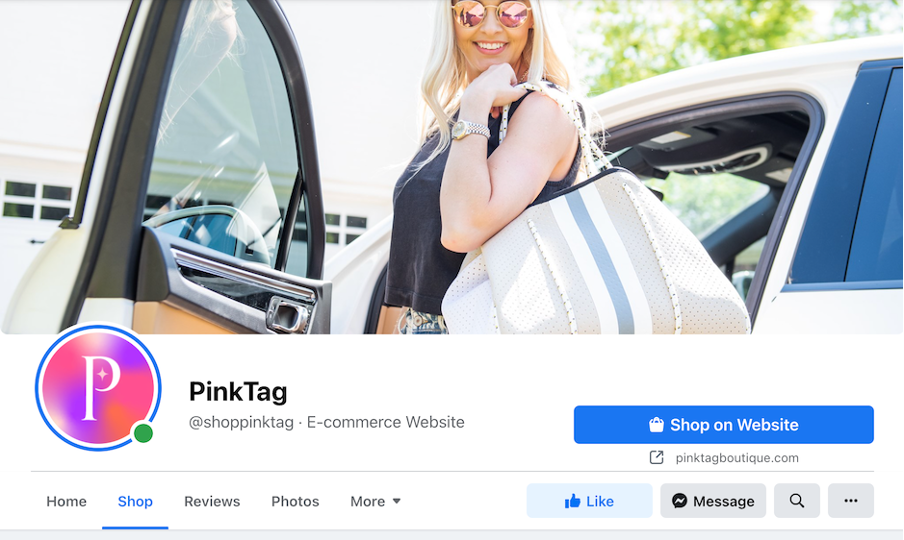
3. Create an editorial calendar
An editorial calendar helps you plan, organize, and schedule the content you want to share across each social media channel. You can keep track of crucial elements, such as:
- The channels you’re posting on.
- The publishing date and time.
- Any required media – images, photos, videos, or audio clips.
- Comments, notes, and approvals from team members as the content is created.
- Post-publishing metrics, such as likes, comments, shares, and visits, to track the success of each item.
You can create various types of social media content for ecommerce. And remember, not all content has to be focused on selling your products. You could create informational content to help pre- and post-purchase.
And then there are different content formats. You’ll definitely want to consider:
- Short-form video content is popular with all demographics. You can use Stories, Reels, or Live broadcasts to entertain your audience and build a stronger relationship with them. You can also use these formats in your social media ads, too.
- User-generated content is an all-round winner as you’re incorporating social proof into your content strategy. Encourage your customers to share photos and videos featuring your products on social media, tagging your brand. Then, you can re-share them to your profile with a credit to the author.
No matter which social media channels you choose, you can use a combination of organic and paid content. As we saw in the examples above, social media ads played an essential part in each success story.
An editorial calendar also facilitates more efficient workflows, as we’ll see in the next step.
4. Produce and publish high-quality content consistently
An approval workflow ensures your content is reviewed before it’s published, so it’s posted at the right time, in the right place, by the right person.
For example, a robust approval workflow should prevent a Facebook post from being published with a typo in the copy and the wrong image attached.
Depending on your organization, there could be one or many different people involved in the approval workflow.
For example, if you’re a single-person startup, you could use a simple checklist to remind yourself to check your content for spelling and grammar typos, broken links, and incorrect visuals.
On the other hand, if you’re a large organization, you might require a more comprehensive, team-wide sign-off process to collect approval from your legal, marketing, and editorial teams before publishing.
In the long run, a workflow helps your brand consistently:
- Streamline processes
- Reduce errors
- Publish at a much faster rate
- Save money
Step 3: Engage with your audience
As well as publishing high-quality content, you’ll need to make sure that you’re engaging with your shoppers.
For example:
- If you’re using Instagram Shops, you’ll need to reply to product queries via Messenger and Direct Messages and share user-generated content, as we saw with Missoma.
- If you’re using Shopify but offering customer support on Twitter, you’ll need to respond quickly to customer queries.
Whatever platform you’re selling on, Messenger is a versatile tool to engage with your audience. Plus, you can add a chatbot to provide instant support, simulate conversations, ask questions, and gather feedback 24/7.
Step 4: Measure your success
An important part of your social media strategy for selling online is to review and measure your performance. Here you can refer to your goals in Step #1 and check your metrics and social media KPIs.
Using native and advanced social media analytics tools, you can track ecommerce-related data, including:
- Website clicks
- Profile visits
- Social shares from your website
- Mentions from customers
- Ad offers and click-throughs
- Mentions of new products or campaigns
Remember to check both quantitative and qualitative metrics:
- Quantitative – e.g. the number of likes, shares, comments, followers, clicks, conversions, and repeat orders.
- Qualitative – e.g. customer reviews and ratings.
Step 5: Rinse and repeat
After you’ve measured your performance, you can evaluate what worked and what needs adjusting in the next iteration/cycle. our social media strategy for ecommerce will constantly be evolving as you improve continuously.
Selling Online, in a Nutshell
Selling online is a given. The younger generations are pushing the trend, and brands are moving to satisfy that demand.
Whether you choose the ecommerce route or the social commerce path, you can rest assured that social media will play an important role in your online selling strategy.



